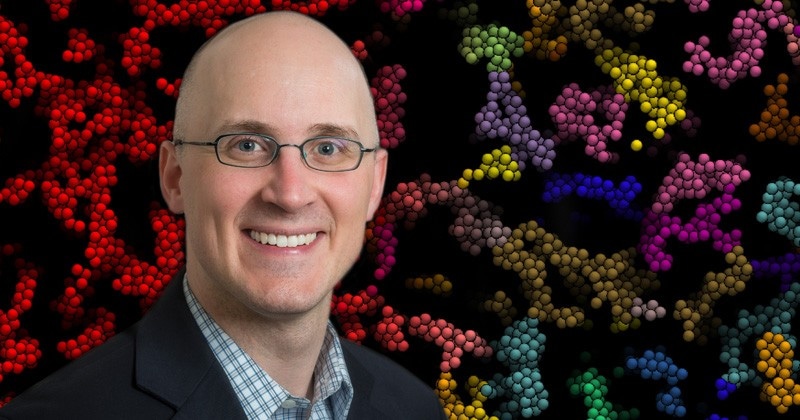May 21 2019
From the toothpaste that is squeezed on the brush as a first thing in the morning, to the yogurt that one slurps down, to the fabric softener used to keep the pajamas soft and cozy, gels are everywhere in consumer products, foods, and in industrial applications, as well.
 A team of scientists, including UD’s Eric Furst, discovered that the elasticity of gels arises from the packing of clusters of particles in the gels, which the group dubbed locally glassy clusters. (Image Caption: University of Delaware)
A team of scientists, including UD’s Eric Furst, discovered that the elasticity of gels arises from the packing of clusters of particles in the gels, which the group dubbed locally glassy clusters. (Image Caption: University of Delaware)
However, to date, researchers have neither been able to describe the microscopic structures within gels that offer elasticity, or springiness, to them nor how those structures develop. A research group from the University of Delaware, Massachusetts Institute of Technology, North Carolina State University, and University of Michigan identified that the elasticity of gels is due to the packing of clusters of particles in the gels, which is locally called glassy clusters by the team.
This study, cited in a paper reported in the journal Nature Communications, could help people make better materials and products at the microscale. This knowledge could help firms in the biotechnology, consumer products, agriculture sectors, and more.
Several companies formulate and sell gel products, and at times, the stiffness of gels varies due to instability.
Eric Furst, professor and chair of UD’s Department of Chemical and Biomolecular Engineering and one of the corresponding authors of the paper, keeps an old bottle of fabric softener on his office shelf and uses it to show what occurs when gels separate or “collapse.” The product is intended to be easy to dispense, but when it gets spoiled, it turns gloppy and unpleasant.
Our results provide insight into how to engineer cluster size distribution to control stiffness, flow, and stability of gel materials.
Eric Furst, Professor and Chair, Department of Chemical and Biomolecular Engineering, University of Delaware
Kathryn A. Whitaker, who received a doctoral degree in chemical engineering from UD in 2015 is the first author of the new paper and is presently a senior research engineer at Dow in Midland, Michigan.
Investigating Gels
Gels are semi-solid materials that flow like liquids but also include solid particles. On observing these substances under a microscope, the researchers found that the solid particles within gels create a network, similar to the structure of a building. This structure should be broken in order to make the substance flow so that it can be squeezed or spread thin. If a lot of force is needed to do this, it means that the substance is rigid and has a high elastic modulus. If less force is enough, it means that the substance flows easily and has a lower elastic modulus.
The team of scientists headed by Furst investigated a gel composed of particles of poly(methylmethacrylate) latex (PMMA), generally called acrylic, dispersed in a blend of two colorless liquids, cyclohexyl bromide and cyclohexane. They discovered that this gel was made up of glassy clusters of particles linked to each other with weak regions in between. To gain insight into how these clusters contributed to the gel’s properties, the group had to determine the limits where each cluster started and ended.
“This is like Facebook,” said Furst. “We were trying to figure out—who is connected locally to whom?”
Partner James W. Swan, assistant professor of chemical engineering at MIT, carried out simulations to discover the physics behind the clusters. He later applied graph theory, the mathematical study of graphs, to the simulation data to decipher which clusters are linked to each other, find out the edges of each group, and color-code the clusters. It was like delineating the boundaries of intermingling friend groups.
Next, the scientists compared the simulation results to physical studies of the gels and verified that the links and distributions matched their estimations. They found out that the way these locally glassy clusters pack together decides the material’s elastic modulus. The interconnected clusters function as rigid, load-bearing units inside the gel.
“Until now, no one had seen and described how these clusters packed and how they affected elasticity,” stated Furst. “We brought the puzzle together.”
Other authors of the paper include Zsigmond Varga, a process development engineer at ExxonMobil; Lilian C. Hsiao, an assistant professor of chemical and biomolecular engineering at North Carolina State University; and Michael J. Solomon, a professor of chemical engineering and Dean and Vice Provost for Academic Affairs, Graduate Studies, Rackham Graduate School at the University of Michigan.
This paper took years to make as the researchers followed up on lingering questions that concerned them and provoked them to continue working.
This discovery was the result of the teamwork of the principal investigators, the experimental skills of our students, and the passion and tenacity we all brought as we worked through this problem.
Eric Furst, Professor and Chair, Department of Chemical and Biomolecular Engineering, University of Delaware
Funding for this project was provided by the International Fine Particles Research Institute, the National Science Foundation, and the American Chemical Society (ACS) Petroleum Research Fund.